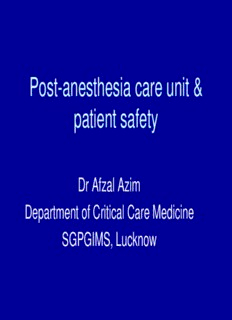
Post-anesthesia care unit & patient safety - PATEL HOSPITAL PDF
Preview Post-anesthesia care unit & patient safety - PATEL HOSPITAL
Post-anesthesia care unit & patient safety Dr Afzal Azim Department of Critical Care Medicine SGPGIMS, Lucknow Historical aspects • 1947-anesthesia study commission report – 50% of deaths in 1st 24 hours after surgery were preventable • 1949 - Having PACU reflected standards of care • Experience of trauma management after 2nd world war • Advances in surgery • Concept of day care surgery Defining and Measuring Patient Safety • We need definitions and methods of measuring safety, its „„shadow‟‟ error, and the degree of preventability. • Understand magnitude of the problem and the degree to which harm is preventable. Definitions of Commonly Used Terms for Patient Safety Shadows of Patient Safety Framework for Measuring Patient Safety in Critical Care Setting How do we know we How often do we use evidence learned from based interventions? mistakes? Culture Ethical Tenets • The ethical principles – beneficence (the duty to benefit another) – nonmaleficence • Principle of justice • Compassion and unrestricted by consideration of personal attributes, economic status, or the nature of the health problem. Futurist goals Three Design Principles for Safety • Design systems to prevent errors • Design procedures to make errors visible • Design procedures that can mitigate harm from errors Nolan T. BMJ 2000; 320:771 Safety Culture in Critical Care Safety culture does not emerge spontaneously. Communication Breakdowns are frequently the root cause of… undesirable outcomes 10
Description: